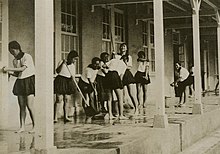Uniform
This article needs additional citations for verification. (September 2022) |

A uniform is a variety of costume worn by members of an
Etymology
From the Latin unus (meaning one), and forma (meaning form).[1]
Corporate and work uniforms

Workers sometimes wear uniforms or

The term uniform may be misleading because employees are not always fully uniform in appearance and may not always wear attire provided by the organization, while still representing the organization in their attire. Academic work on organizational dress by Rafaeli & Pratt (1993) referred to uniformity (homogeneity) of dress as one dimension, and conspicuousness as a second.[2] Employees all wearing black, for example, may appear conspicuous and thus represent the organization even though their attire is uniform only in the color of their clothing, not in its features. Pratt & Rafaeli, (1997) described struggles between employees and management about organizational dress as struggles about deeper meanings and identities that dress represents.[3] And Pratt & Rafaeli (2001) described dress as one of the larger set of symbols and artifacts in organizations, which coalesce into a communication grammar.[4]
Armed forces and security
Military uniform is the standardised
Military personnel in most armed forces and some civilian officials may wear some or all of the following:
Medical workers

Uniforms can distinguish various categories of staff in medical institutions: doctors, surgeons, nurses, ancillary staff and volunteers.
Traditional female nurses' uniforms resemble uniforms (habits) worn by religious orders.[5][6]
Equipment - notably stethoscopes - worn like a badge of office, may accompany or replace medical uniforms.
Educational

Uniforms are required for students in many schools in different countries. School uniforms vary from a standard issue T-shirt to rigorous requirements for many items of formal wear at private schools. School uniforms are in place in many public schools as well.
Countries where mandatory school uniforms are common include
Some universities in the DPRK require students to wear uniforms.
Diplomats
From about 1800 to after the Second World War, diplomats from most countries (and often senior non-military officials generally) wore official uniforms at public occasions. Such uniforms are now retained by only a few diplomatic services, and are seldom worn.
Police

Members of the police in every country have a uniform for identification as law-enforcement personnel or agents. They are distinguished from the public by the uniform the police wear during overt policing activity. Usually each country has its own different police uniform.
Contrast
Sports
Most, if not all,
To prevent the confusion (for officials, players, and fans) that might result from two opposing teams wearing uniforms (kits) with similar colors, teams have different variations for "
Domestic workers
Domestic workers are often required by their employers-managers to wear a uniform.
Prison
A prison uniform is any uniform worn by individuals incarcerated in a
Beautician
The beauticians use uniforms to protect their skin from harmful chemicals and acid. These chemical resistant and water proof uniforms are not only safe to work in but also provide a professional, polished appearance throughout the day.
Scouting

The Scout uniform is a specific characteristic of the Scouting movement, in the words of Baden-Powell at the 1937 World Jamboree, "it covers the differences of country and race and make all feel that they are members one with another of one World Brotherhood". The original uniform, which has created a familiar image in the public eye, consisted of a khaki button-up shirt, shorts and a broad-brimmed campaign hat. Baden-Powell himself wore shorts since being dressed like the youth contributed to reducing perceived "distance" between the adult and the young person. Nowadays, uniforms are frequently blue, orange, red, or green, and shorts are replaced by long pants in areas where the culture calls for modesty, and in winter weather. The campaign hats have also been dropped in some Scouting organisations.
Buttons
Some uniforms have specially-manufactured buttons, which, in the case of antiques, often outlast the fabric components of the uniform, and become highly collectable items.[9] Nowadays, buttons come in different materials, shapes sizes and colors.
Hygiene
In some countries or regions such as the
See also
- Costume
- Court dress
- Dress code
- Industrial laundry
- Political uniform
- Social behavior
- Uniform fetishism
References
- ^ Atkinson, Charles Francis (1911). . In Chisholm, Hugh (ed.). Encyclopædia Britannica. Vol. 27 (11th ed.). Cambridge University Press. p. 582.
- .
- doi:10.5465/256951.
- .
- ^
Compare: Finkelman, Anita Ward; Kenner, Carole (2010). Professional Nursing Concepts: Competencies for Quality Leadership. Jones & Bartlett Publishers. ISBN 9781449617677. Retrieved 2016-11-08.
Prior to the all-white uniform, the nurse's uniform was gray or blue, similar to a nun's habit and to the uniforms worn during Florence Nightingale's time [...].
- .
- ^ Whitaker, Lang (July 18, 2017). "NBA, Nike unveil new uniforms for 2017-18 season". NBA.com. Retrieved October 15, 2018.
- ^ "White at Home in the NFL". www.uni-watch.com. Retrieved July 5, 2015.
- ^ HM Revenue & Customs. "SE67240 - Tax treatment of nurses: expenses deductions - laundering uniforms - amount to be deducted". Retrieved 1 November 2007.
- ^ Australian Taxation Office. "Claiming a deduction for laundry/dry cleaning of work clothing". Archived from the original on 27 February 2008. Retrieved 1 November 2007.
